Stanley's 100th Anniversary Site

Overcoming Many Challenges
President Kitano's measures steadily produced results. Stanley Electric's corporate structure was gradually becoming more solid, thanks to productivity improvement through the activity of SNAP, product development best suited to the market needs, and investment with increased efficiency. However, the company was affected by rapidly worsening economic conditions due to the financial crisis as a result of the bankruptcy of the Lehman Brothers in September 2008. On March 11, 2011, when the company was recovering from the effects of the economic downturn and in the middle of relocating its headquarters, the Great East Japan Earthquake occurred. Further, in July of the same year, the company's performance worsened due to the flood disaster in Thailand.
All Stanley group companies worked hard and pulled themselves together to overcome the various disasters.
CHRONOLOGY
-
2003
-
May
LED-T/L line beam headlamps on the Honda CBR600RR (European specifications)
-
Jun.
Introduced positions of executive officers
-
Jul.
The Stanley Ladies Golf Tournament was reopened
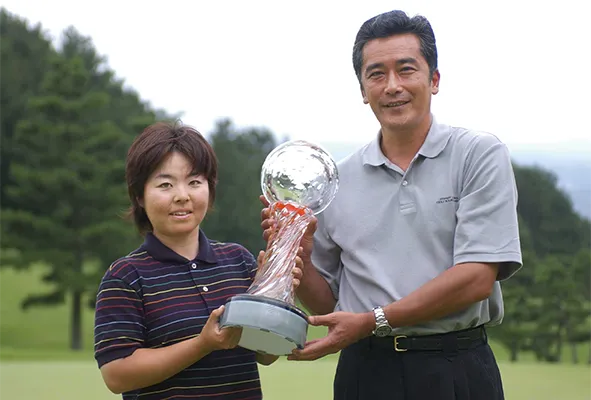
The Stanley Ladies Golf Tournament was reopened
-
Sep.
De-listing from the Osaka Stock Exchange
-
Established Stanley Electric Holding Asia-Pacific Pte. Ltd. (SEAP)
-
Dec.
Capital participation in Samlip Industrial Co., Ltd. of South Korea
-
Night View headlamps (with visible light cutting and infrared transmission functions) on the Toyota Crown)
-
Launched a project to eliminate water-related issues

The Stanley Ladies Golf Tournament was reopened
-
-
2004
-
Feb.
Built-in strobe on the au A5502K cellular phone
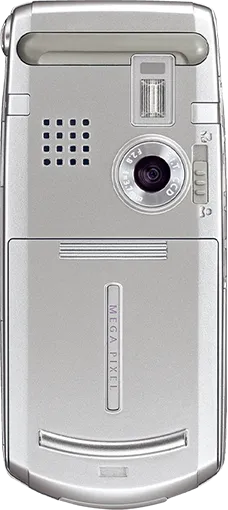
Xenon type strobe on the au A5502K, the first application to mobile phones
-
Mar.
Integrated Kumamoto Office and Hamamatsu Plant as Hamamatsu Factory
-
Apr.
Launched the 2nd phase of Three-year Medium-term Management Plan
-
Reorganized the Hatano Factory
-
Launched Helios, a project to invigorate the R&D divisions
-
Introduced the SQA (Stanley Quality Award) system
-
Oct.
Relocated Stanley Iwaki Works to a new factory
-
Dec.
The Stanley Technology Exhibition 2004, "The Five Ways of Creating Value with Light," took place
-
-
Delisted Stanley's stock (depositary shares) on the Frankfurt Stock Exchange

Xenon type strobe on the au A5502K, the first application to mobile phones
-
-
2005
-
Mar.
Headquarters certified ISO 14001 as first non-production establishment
-
Launched Renaissance, a project to reform sales and marketing, and support strategy planning
-
May
Established Stanley Group Code of Conduct
-
Established Stanley Electric Korea Co., Ltd. (SEK)
-
-
2006
-
Jan.
Launched a project to eliminate bulb-related issues
-
May
Organizational improvements based on the resolution of the Basic Principles of Building an Internal Control System
-
Jul.
Established Stanley Electric Holding Europe Co., Ltd. (SEEU)
-
-
2007
-
Apr.
Launched the new reform project, Millennium
-
Launched the 3rd phase of Three-year Medium-term Management Plan
-
Jul.
Opened the Opto Technical Center (OTC)
-
Dec.
The Stanley Technology Exhibition 2007, "The Five Ways of Creating Value with Light," took place
-
-
2008
-
May.
H/L on Toyota Century
-
Dec.
Temporary business shutdown and elevation of approval authorities in response to lower performance due to the 2008 financial crisis.
-
-
2009
-
Jun.
Stanley's first LED headlamps on the Mitsubishi's electric vehicle "i-MiEV," and started mass production
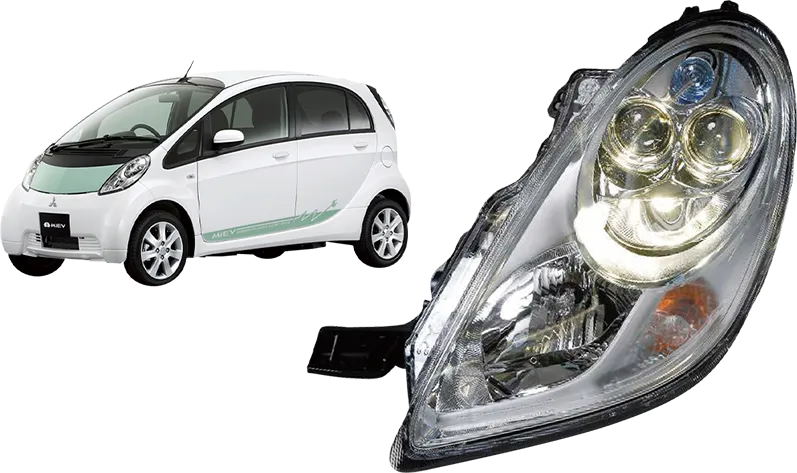
LED headlamps on the "i-MiEV," the world's first mass produced electric vehicle from Mitsubishi
-
Oct.
Established Stanley Electric do Brasil Ltda. (SEB)

LED headlamps on the "i-MiEV," the world's first mass produced electric vehicle from Mitsubishi
-
-
2010
-
Apr.
Launched Stanley Group Second Long-term Management Goals
-
Launched the 4th phase of Three-year Medium-term Management Plan
-
Oct.
Acquired approval for test run of test vehicles mounted with ADBs on public roads from Japan's Minister of Land, Infrastructure, Transport and Tourism
-
Relocated Stanley Niigata Works to a new factory
-
Dec.
The Stanley Technology Exhibition 2010, "The Five Ways of Creating Value with Light," took place
-
-
2011
-
Mar.
The Great East Japan Earthquake caused serious damages to Stanley Iwaki Works and Stanley Miyagi Works
The Great East Japan Earthquake
Stanley Miyagi Works, which was hit by a severe earthquake with a vibration level of 7, saw its buildings and production lines damaged, but there were no injuries or deaths. Support staff arrived there and started recovery work in earnest as early as March 19, 2011. Production resumed on March 21, only ten days after the disaster.
Stanley Iwaki Works also suffered huge damages as large facilities collapsed and materials and products were scattered around its production lines. In addition, employees and their families were evacuated to shelters that were set up at Stanley Niigata Works. This was to secure their safety because of the spreading of radioactive material after the nuclear plant accident. Employees and their families in Niigata dedicated their efforts to help the evacuees with daily necessities and meals. When safety was confirmed, all the evacuated employees returned to Iwaki on March 25, and they started to take action to resume production on March 28.
Although many other operation bases in East Japan such as the Tsukuba Research Laboratory, Utsunomiya Technical Center, and Stanley Tsuruoka Works were also affected by the disaster, it was fortunate that no employees were injured.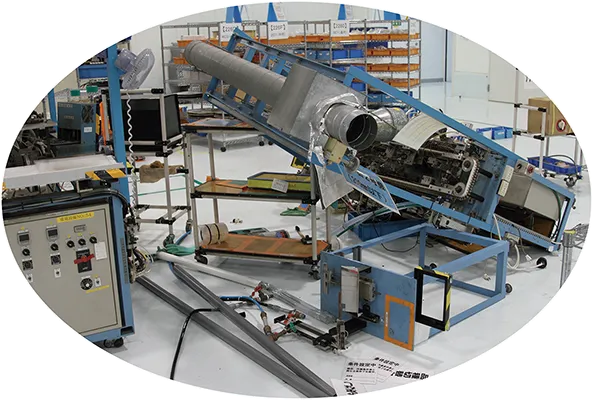
Stanley Iwaki Works damaged by the Great East Japan Earthquake
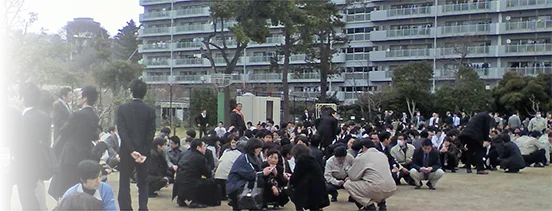
Employees evacuated into a park nearby during the Great East Japan Earthquake
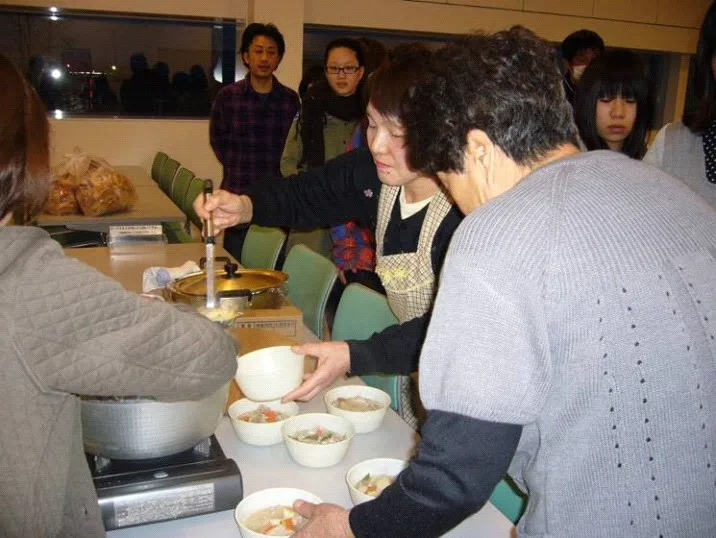
Camp-out meal by families of STANLEY NIIGATA WORKS employees
-
Headquarters started operations at a temporary location (Ebisu)
The Relocation of the Headquarters to the Yebisu Garden Place Tower
In July 2010, Stanley Electric decided to rebuild its headquarters building. The decision came after the completion of the earthquake-proofing of the company's factories--a higher priority--which left the headquarters as an only remaining building. The company planned to have its headquarters temporarily in the Yebisu Garden Place Tower during the construction of the new office building and to return to Nakameguro in December 2012.
On March 11, 2011, a day before the temporary relocation, the Great East Japan Earthquake occurred when employees were packing up for the move. Since the headquarters building was very old, concrete rubble pieces fell from its joining sections. In a cloud of dust like a smoke screen, evacuation was carried out to Nakameguro Park. Soon afterward, the safety of all employees present on that day was confirmed. The disaster struck on the very last working day at the former headquarters.
The relocation faced many difficulties. Many people were unable to go back home and it was impossible to gather workers from moving companies. It was also impossible to use elevators for moving goods at the relocation site. After two days of round-the-clock work, all office furniture, equipment and document files were managed to be carried into the new headquarters before the start of the working hours, early on the morning of March 14. Some staff of the General Affairs Department worked overnight at the headquarters to carry out the relocation work while confirming the situations at regional workplaces affected by the earthquake. -
May
Established Stanley Electric (China) Investment Co., Ltd. (SECN)
-
Oct.
Severe flooding in Thailand caused a temporarily shutdown of ASI and THS
Flood Disaster in Thailand
Large scale floods occurred in Thailand from July to October in 2011. ASI and THS were affected by the disaster. Sandbags were piled up around the factories to prevent water from entering their premises, but eventually factory buildings became flooded and some die molds were submerged. The two companies closed some of their factories. Although both companies resumed production on some production lines in November, the floods significantly affected supply chains because Thailand was a hub for global parts supply.
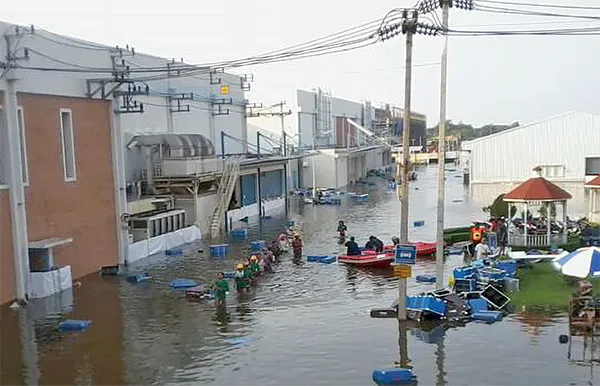
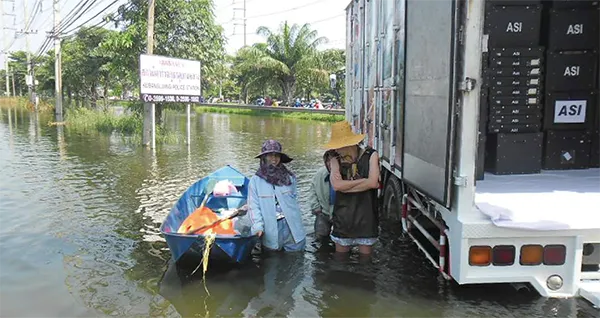
THS (left) and ASI (right) flooded in Thailand
-
Established Wuhan Stanley Electric Co., Ltd. (WSE)
-
Dec.
Established Stanley Electric Sales of India Pvt. Ltd. (SSI)
The Great East Japan Earthquake
Stanley Miyagi Works, which was hit by a severe earthquake with a vibration level of 7, saw its buildings and production lines damaged, but there were no injuries or deaths. Support staff arrived there and started recovery work in earnest as early as March 19, 2011. Production resumed on March 21, only ten days after the disaster.
Stanley Iwaki Works also suffered huge damages as large facilities collapsed and materials and products were scattered around its production lines. In addition, employees and their families were evacuated to shelters that were set up at Stanley Niigata Works. This was to secure their safety because of the spreading of radioactive material after the nuclear plant accident. Employees and their families in Niigata dedicated their efforts to help the evacuees with daily necessities and meals. When safety was confirmed, all the evacuated employees returned to Iwaki on March 25, and they started to take action to resume production on March 28.
Although many other operation bases in East Japan such as the Tsukuba Research Laboratory, Utsunomiya Technical Center, and Stanley Tsuruoka Works were also affected by the disaster, it was fortunate that no employees were injured.-

Stanley Iwaki Works damaged by the Great East Japan Earthquake
-

Employees evacuated into a park nearby during the Great East Japan Earthquake

Camp-out meal by families of STANLEY NIIGATA WORKS employees
The Relocation of the Headquarters to the Yebisu Garden Place Tower
In July 2010, Stanley Electric decided to rebuild its headquarters building. The decision came after the completion of the earthquake-proofing of the company's factories--a higher priority--which left the headquarters as an only remaining building. The company planned to have its headquarters temporarily in the Yebisu Garden Place Tower during the construction of the new office building and to return to Nakameguro in December 2012.
On March 11, 2011, a day before the temporary relocation, the Great East Japan Earthquake occurred when employees were packing up for the move. Since the headquarters building was very old, concrete rubble pieces fell from its joining sections. In a cloud of dust like a smoke screen, evacuation was carried out to Nakameguro Park. Soon afterward, the safety of all employees present on that day was confirmed. The disaster struck on the very last working day at the former headquarters.
The relocation faced many difficulties. Many people were unable to go back home and it was impossible to gather workers from moving companies. It was also impossible to use elevators for moving goods at the relocation site. After two days of round-the-clock work, all office furniture, equipment and document files were managed to be carried into the new headquarters before the start of the working hours, early on the morning of March 14. Some staff of the General Affairs Department worked overnight at the headquarters to carry out the relocation work while confirming the situations at regional workplaces affected by the earthquake.Flood Disaster in Thailand
Large scale floods occurred in Thailand from July to October in 2011. ASI and THS were affected by the disaster. Sandbags were piled up around the factories to prevent water from entering their premises, but eventually factory buildings became flooded and some die molds were submerged. The two companies closed some of their factories. Although both companies resumed production on some production lines in November, the floods significantly affected supply chains because Thailand was a hub for global parts supply.
THS (left) and ASI (right) flooded in Thailand
-
-
2012
-
Dec.
Completed the new headquarters building.
-